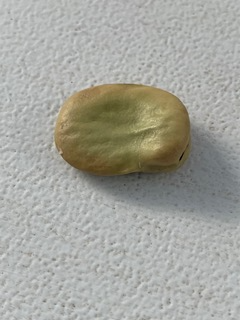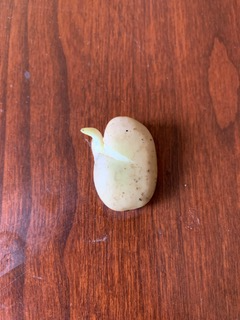Bean There, Do That!
I understand that beans are considered boring, except by youth who celebrate their more odiferous side effects. But as gardeners, be advised, that the simple bean can be the highlight of your winter garden. To justify this praise, I will focus on the highly underutilized but extraordinary fava bean.
The fava bean, as a seed, is underestimated. Its most notable feature is its size. It is a “hunk” of a bean, easy to handle and maneuver. Prior to planting fava beans, soak them overnight to soften their outer protective coats, which will aid the germination process. They can be sown directly into the soil in the fall and will grow quickly over the winter. Plant 1-2” in depth, 6” apart. The bean seed will provide the initial nutrients for the plant to start growing until the leaves can begin photosynthesis. Fava beans are easy to grow and can be left unsupported in their upward journey. They require regular watering until established, but thereafter can do quite well with minimal irrigation. I usually mulch mine with seedless straw to retain soil moisture and deter weeds. In late spring, the plants will flower and soon after develop pods. They will be ready for harvest when they are plump and have a slightly glossy sheen. Freshly shucked, the bright beans are a vivid shade of green. To prepare the beans for eating, it is easiest to blanch them and pop the outer shell off. After that, they are ready for soups or to be pureed with garlic to create a delicious healthy spread. Fava Beans themselves are like little nutritional bombshells, both fibrous and protein packed.
The real bonus of growing fava beans in the garden is that they are a member of the legume family and as such are considered a cover crop. Legumes such as peas and beans have the ability to absorb nitrogen from the air and lock it into the soil. This helps to prepare soil for summer crops such as tomatoes, which are heavy feeders and require nitrogen to produce fruit. Not only do fava beans increase soil fertility but they all support an interactive web of life under the soil. This is the “sexy” part of our boring little bean, because as their roots expand down and out, they facilitate relationships with soil microbes. This mutually beneficial interaction is good for both the plant and the soil environment. Healthy soil, in turn, means less pests, better food production, happier gardeners and a nicer world. That's my take on it, anyway.
When you are ready to transition to summer crops, cut the fava bean plants off at its base. Do not disturb the soil, but instead leave the roots in the ground. They have nodules of nitrogen attached and have created an interactive micro ecosystem ready to support whatever you are going to plant next. Cut up the tops of the plant and lay the greens right on the soil to decay. Over the winter, your fava bean plants have improved your soil without much effort on your part. Cover crops, such as these plump, industrious beans are superheroes of soil and I hope you will consider planting them in your winter garden.

Fava bean in flower.



